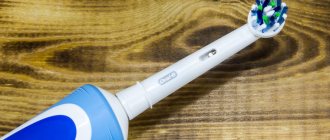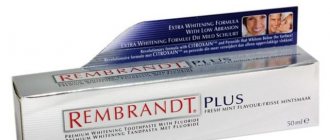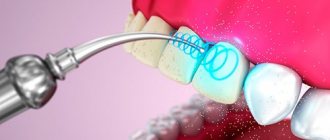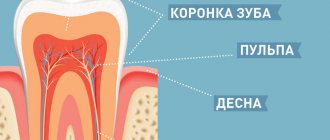Home › Dentistry
06.08.2018
Brushing your teeth is a daily procedure that has been part of your daily routine since early childhood. Despite this, people who regularly care for their teeth and gums develop various dental diseases. Dentists believe that these problems are caused by improper oral care. Therefore, let's talk about how to choose toothpaste and toothbrush, why you should brush your teeth, how to brush your teeth correctly video .
Choosing a toothpaste
Toothpaste is one of the important elements for caring for the surface of teeth. Here are some simple recommendations to help you decide on a huge range of products.
- We focus on the individual condition of the oral cavity and our own sensations.
- We periodically combine/change toothpastes.
- We take breaks from using fluoride-containing toothpastes. They are great for preventive purposes, but excess fluoride is harmful.
- We do not overuse toothpastes with a whitening effect. Thanks to special enzymes, they make it easier to remove plaque from teeth, but at the same time they harm the enamel.
- We select special products for children according to their age group.
How to treat teeth for free under compulsory medical insurance policy
After the law on free medical insurance was adopted, patients at dental clinics had a lot of questions. For example:
- How does dental treatment work for free under the compulsory medical insurance policy (compulsory health insurance)?
- What services do dental clinics provide under this type of insurance?
If you visit a public medical institution or a clinic under a compulsory health insurance policy, you are given the opportunity to receive the following types of medical services :
- consultation with a dentist;
- treatment of acute caries, as well as procedures during the recovery period after therapy;
- treatment of abscess, alveolitis, and other pathologies;
- carrying out hygienic procedures (for example, removing tartar, varnishing teeth, etc.);
- surgical methods of influencing the process of tooth growth in the presence of any problems with the gums;
- reduction of dislocated jaw joint;
- removal of a diseased tooth;
- administering local anesthesia;
- X-ray of diseased teeth;
- selected orthodontic procedures.
In any case, if you do not see any problems with your teeth in this list, and if you have doubts whether they are included in the category of free treatment, contact your dentist and get advice on all issues, including the possibility free service in the clinic according to the insurance policy.
The dentist will give the necessary explanations about which procedures are free and which can be done in the clinic only for a fee.
Who has the right to free treatment under the compulsory health insurance policy?
Free dental treatment applies to all segments of the population who have an insurance policy for free medical care. Accordingly, children's dental clinics provide services to children.
During pregnancy, for examination of the oral cavity, women are referred to a clinic for sanitation according to their registration, where a free appointment, consultation and necessary treatment by dentists are provided.
The legislative act on free dental treatment applies equally to everyone, both working members of society and citizens on a well-deserved pension. You can receive any assistance under your insurance policy at a clinic according to your registration, or you can receive assistance at a public medical institution located near your home. You will be provided with free services that are specified in the insurance policy.
If you have any dental problems: a tumor appeared on the gum after the tooth was treated, an inflammatory process in the tooth was discovered - gumboil, acute toothache occurred due to the development of caries, then it is necessary to remove the wisdom tooth. A dentist will help you solve these and many other problems. Do not try to get rid of such pathologies yourself at home. All kinds of rinsing and applying a piece of lard to the sore spot will not help.
It is worth noting that all materials necessary for treatment (various filling preparations, instruments, syringes, painkillers, etc.) are also given to patients who have an insurance policy for compulsory medical insurance free of charge.
Choosing a toothbrush
The toothbrush is the number 1 enemy of dental plaque. Her choice must be approached no less carefully. The nose is where to start. Here are a few characteristics of brushes that you should focus on.
- The hardness of the toothbrush. A soft brush may not be effective enough for cleaning, but will work for bleeding gums. Hard can damage the enamel, but does an excellent job of removing plaque. Most people choose medium-hard toothbrushes.
- Product material. It is safer to use brushes made of synthetic materials. It is not recommended to buy brushes made from natural materials, because... Microbes can linger and multiply on their surface.
- Type of brush. Conventional, electric, ultrasonic – which one to choose? There is no clear answer. An electric toothbrush is easy to use, but can damage your tooth enamel. Therefore, it is recommended to use it 2-3 times a week, and in other cases – as usual. An ultrasonic brush is very effective in combating plaque and bacteria. The disadvantages include its high cost and the presence of individual contraindications.
Tooth cyst
Dentists believe that the earlier a cyst is diagnosed, the easier it is to treat. Therefore, experts recommend that their patients visit a doctor at least once a year for a preventive examination and check their teeth for the formation of cysts. This is especially true for teeth that have been filled more than ten years ago or were under crowns.
Treatment of dental cyst
The easiest way to cure a patient from cyst formation is to remove the affected tooth and treat the gums. Just a decade ago, dentists did only this. Patients had their damaged teeth removed; when complaints were made to the doctors, they complained that there were no other options to get rid of the cyst. Recently, a revolutionary solution has been found in the treatment of cysts and granulomas. Today the cyst can be removed, while the tooth is preserved.
Both surgical and therapeutic methods are used in the treatment of cysts and granulomas . Both of them have advantages and disadvantages. The dentist determines which method of therapy to choose on an individual basis with the patient.
Surgical methods
Of the surgical treatment methods, the most commonly used operation is called cystectomy , when the cyst and the affected tip of the tooth root are removed. Its main advantage is absolute reliability. Disadvantage: the procedure is quite complicated, and not every surgeon will decide to perform it on a molar.
The second type of surgical intervention is hemisection . This operation is less gentle. It is done if it is not possible to save one of the roots of the tooth. The surgeon removes the cyst, completely removes the root that is already hopeless, and partially removes the tooth located above the root. After surgery, the tooth defect is covered with a crown.
When an operation is performed, it is not possible to save a tooth in two cases:
- if the tooth is completely located in the area of cyst formation and wobbles extremely strongly;
- or the tooth is destroyed almost to the very base.
Therapeutic method
With the therapeutic method of treatment, it is possible to rid the patient of the cyst without surgical intervention. This method is ideal for the treatment of granulomas . It is clear that this therapy is less stressful for the patient. But it can take a lot of time and does not provide a 100% guarantee of cure for cyst formation.
The dentist does not perform operations; he reaches the cyst in a roundabout way:
- At the beginning of treatment, the affected tooth is drilled out and the root canal is completely cleaned.
- At depth, the tooth root is transformed into a cyst, so the contents of the cyst in this case can freely come out through the formed passage.
- The dentist thoroughly rinses the root canal using disinfectants, as well as antimicrobial agents and solutions that destroy the cyst shell.
- Further therapy continues only after the cyst cavity is completely clear of affected cells and microbes.
- Next, the dentist fills the cavity with a special paste, which helps the formation of normal bone tissue in the affected area.
- The tooth is then filled.
- If six months later the cyst is not visible on the x-ray, then the therapy was successful.
About 70% of patients get rid of cysts using this method.
Progressive non-surgical methods of treating cysts and granulomas include depophoresis . This method makes it possible to remove infection simultaneously in all tooth root canals, and not just in the one that was drilled. The tooth canal is widened and copper-calcium hydroxide is placed into it. Due to the influence of a small electric current, the suspension moves and falls into those places where the drill cannot penetrate, it reaches the cyst and kills the affected cells and microbes.
After three depophoresis procedures, the cured tooth is filled, and the suspension that remains in the tooth continues to engage in the healing process. Advantages of the method: it can help eliminate the cyst in 95% of patients. Disadvantage: not all dental clinics have the technical equipment to perform depophoresis.
How to brush your teeth correctly
There are billions of microorganisms in the mouth. Our teeth serve as tools for chewing food. Its remains remain in the oral cavity, which creates a breeding ground for microorganisms. This results in plaque that produces acid. It destroys tooth enamel. If you do not interfere with this process in any way, i.e. Brushing your teeth regularly will make them susceptible to tooth decay. Therefore, here are some basic tips in oral hygiene (also see the visual example in the picture above):
- The frequency of hygiene procedures is 2 times a day, morning and evening after meals.
- The duration of the cleaning process is approximately 3 minutes.
- The location of the brush to the gums and teeth is at an angle of 45 degrees.
- To prevent the spread of bacteria throughout the oral cavity, the procedure should be divided. First brush the lower row of teeth, then the upper, gradually moving from the front teeth to the back.
- To achieve the best result, clean your tongue, because... Many microorganisms accumulate on it, and use mouth rinses.
Also watch how to properly brush your teeth video .
Save the article to your social network!
How to treat teeth during pregnancy
The state of pregnancy is, of course, wonderful! Now you will need to plan all the changes in your life and make adjustments in connection with the new condition. Proper nutrition, positive emotions, necessary rest. However, the first number on the list of important activities should be a visit to the dentist.
Even if you haven't had dental problems before, you can almost guarantee that you may now have them. Therefore, you should avoid problems and have all your teeth checked by a dentist. Otherwise, the state of pregnancy can negatively affect not only your health, but also the condition of your child.
Is it necessary to treat teeth during pregnancy? Definitely yes!
During pregnancy, changes in calcium metabolism . Calcium reserves in the mother's body are used to form the baby's bone tissue. The lack of this microelement in the body of a pregnant woman is a common occurrence. And if a woman also has toxicosis, then there is no need to talk about the required amount of calcium in the body: it is almost impossible to get it through food, and besides, with toxicosis, the existing supply of calcium is washed out. In such a situation (or in another case when there is not enough calcium in the body to provide the baby with it), the mother’s body looks for reserves in other places. Therefore, the teeth are the first to be affected.
The next factor is the salivary gland . During pregnancy, the nature of its work changes, this leads to a change in the composition of saliva. As a rule, it contains components that protect tooth enamel from caries. However, during pregnancy, the protective functions of saliva weaken. In addition, the pregnant woman’s immunity also decreases; in addition to infections, the expectant mother’s body is also susceptible to caries. Doctors believe that 30% of expectant mothers who have hidden infections experience infection of the fetus, in which case a child is born with reduced immunity , impaired function of the gastrointestinal tract, and the development of other diseases. In addition, there is evidence that with this option the child will also suffer from caries.
In addition to caries, pregnant women often experience dental diseases: pulpitis , periodontal disease and gingivitis . For this reason, the oral cavity and teeth of a pregnant woman must be strictly controlled.
Dental treatment during pregnancy is a necessity!
Are fluorography and x-rays dangerous for a pregnant woman?
All precautions regarding fluorography or anesthesia of the expectant mother are unfounded. Today, dental clinics are provided with modern painkillers, which almost do not enter the placenta and do not have vasoconstrictor components. Therefore, anesthesia does not entail any danger for either the pregnant woman or her child.
This also applies to x-rays . To carry out high-quality dental treatment (especially when it comes to root canal therapy), fluorography is indispensable. Don't be afraid to take pictures. Because, first of all, during the procedure you are protected by a lead apron. In addition, the dose of X-rays is ten times less than that which can cause harm to health. And modern equipment has a radiography method, in which X-rays are projected onto a special sensitive sensor, and the risk of such radiation is reduced tenfold. Also, the X-ray beam is directed directly into the bone of the tooth, so it cannot reach the child in any way.
Therefore, dental treatment during pregnancy is not only possible, but also necessary. If you experience problems with your teeth, contact your dentist immediately. If they are ok, visit a doctor for preventative measures. Don't let hygiene issues get you down during this special time. Treatment at a dental clinic will not affect the formation of the fetus, but diseased teeth can seriously threaten its development.
Please note that not all dental procedures during pregnancy are safe.
- It is necessary to treat your teeth, but you should not remove or install dentures during pregnancy.
- The same applies to teeth whitening with chemicals and gels.
Gingivitis - causes of gum disease
The very first signs of gum disease are light bleeding, noticeable when brushing your teeth. These manifestations of gingivitis, which are not, as some believe, related to the stiffness of the bristles of the brush, can be accompanied by bad breath and the viscous consistency of saliva. Subsequently, as the disease progresses, peculiar pockets, empty cavities, form in which food and plaque accumulate between the gums and teeth.
The gums recede, exposing the base of the teeth, which begin to react to cold or sour foods, as well as to touch. If you do not take measures to treat the gums, they cease to support the teeth, the dental cells begin to atrophy and the teeth begin to loosen and fall out.
If the gums are healthy, then there is no doubt about it. Deviations from the norm, which are the reason for a visit to the dentist, are not only pain and increased sensitivity to food:
- gums turn red;
- become more loose;
- Dark spots may appear on the teeth.
According to statistics, more than 80% of the population over 25 years of age is susceptible to periodontal diseases, but every year gingivitis becomes younger and in some cases is detected already at kindergarten age.
Among the negative aspects of this disease is the increased risk of developing gingivitis in children whose parents already suffer from this disease. Gingivitis often accompanies more severe diseases associated with the endocrine system. The reasons for its occurrence may be poor oral care, lack of vitamins and stressful situations.
Everyone knows that if you have pain in your teeth or inflammation of your gums, you need to see a specialist. However, there are situations when immediate treatment is impossible for some reason, then it is necessary to take certain measures to calm the pain on your own.
Treatment of gingivitis
Inflammation of the gums can be not only chronic, but also acute, when numerous ulcers appear in the oral cavity. Treatment begins with high-quality teeth cleaning using a dentist’s instrument.
a cyst may appear on the gum. The danger of this abscess is that if it ruptures, the contents along with blood can be spread throughout the body. In the early stages, the cyst is treated by simply cleaning its cavity, while in advanced cases tooth extraction may be required.
If part of the tooth wall has broken off, then a visit to the dentist is essential. After the doctor fixes the tooth, you can return to a full life on the same day.
Flux , manifested in the form of a cheek tumor, can be caused by an untreated cyst, gingivitis and caries. It is forbidden to warm up and rub the swollen area yourself, otherwise the pus may spread further. With flux, under local anesthesia, the abscess is cut, the pus is cleaned out, all that remains is to undergo a course of antibiotic treatment.
After tooth extraction, pain persists for several days; the pain can be calmed with the help of ice compresses on the sore spot, which are applied for a quarter of an hour, after which they are removed for the same period of time. However, if no improvement is observed within 3 days, you should visit a doctor.











